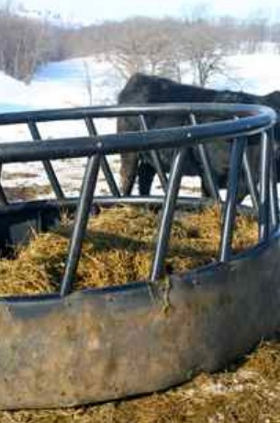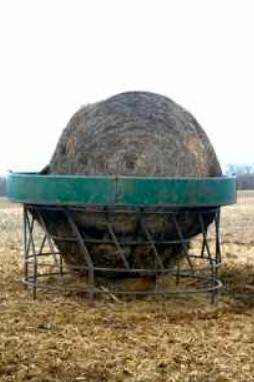By Bill Halfman
With hay being in short supply in some areas I thought it might be beneficial to re-post this article that Dr. Radunz and I put together back in 2011.
Winter-feeding of the beef cows represents the greatest expense in most beef cow-calf enterprises. Currently high feed prices, even for hay, should cause farmers to evaluate their winter-feeding strategies to identify ways to reduce feed costs through minimizing feed waste.
In the upper Midwest a mature cow will eat approximately 3 tons of hay during a common 6-month winter-feeding period. You can easily double your hay usage, if your method of feeding is to place bales out in the pasture or lot without any type of feeder. In this situation the hay becomes expensive bedding for the cows. Thus you will also double your winter feed costs, which at current prices can easily add $300 per cow. Even when feeding hay with hay feeders the waste can vary from 15-50% depending on type of feeder thus significantly increasing your feed costs.

Ring Hay Feeder with hay saver panel
Michigan State University evaluated waste from different types of hay feeders in a study. The results showed some types of feeders do a better job of reducing round bale hay loss than others. This study compared 1) typical ring feeder with a solid panel around the bottom (see picture to left) 2) a cradle type hay feeder with slanted vertical bars so cow could access hay, but not place their head inside the feeder; 3) a silage feeder type wagon, and 4) a cone type hay feeder similar to the feeder pictured below, but with a sold panel at the bottom to keep any loose hay in the feeder.
Dry matter hay waste was 3.5%, 6.1%, 11.4% and 14.6% for the cone, ring, feeder wagon and cradle feeders, respectively. If a farm currently estimates hay waste of 20% from using a bale ring without a solid panel, by switching to a cone style ring feeder, they could reduce overwinter hay costs by $53 dollars per head (hay = $100 per ton). For a 20 head cow herd this would result in a total feed savings of $1069 for the winter.

Cone Feeder no hay saver panel
The researchers also shared the following observations regarding hay feeder design that may help reduce feed losses
• Provide enough distance between the outside of the feeder and the feed. Feeders, which allow cows to be able to comfortably keep their heads within the feeder perimeter, reduce feed losses.
• Avoid bars or dividers between feeding stations. Design features, which allow more access to the hay by reducing a cow’s inclination to push or butt another cow to get access to the hay, will reduce hay losses.
• Provide a comfortable feeding height. Cows prefer to eat with their ears are lower than the top of their shoulders similar to how they eat grazing. Cows that reach over the top of the feeder to get hay also tend to waste more.
• Use a hay saver panel. Feeders designed to sit on the ground will benefit from having a solid panel at the bottom to keep hay inside the feeder. In the pictures, the ring feeder has a hay saver panel whereas the cone feeder does not. The cone feeder could be improved by placing a ‘hay saver’ panel at the bottom.
A final tip to help reduce feed losses is to place a new bale in the feeder when only 10% of the bale is left. This will force the cows to eat a majority of the bale as well as make sure there is adequate room for the new bale. If you are in the market for new bale feeders, keep this study in mind when selecting a feeder. Modifications can also be made to current feeders to help reduce feed losses.
Click here to see more...